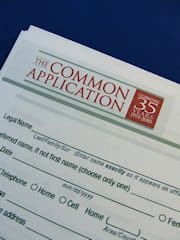There’s no doubt about it … college is expensive. At top-rated private universities, the annual cost can be $55,000 and up. Some public schools charge out-of-state students $40,000 and up. With any luck, however, your child or grandchild will qualify for financial aid. These days, a surprisingly high percentage of students do.

If your student does score some financial aid, what are the tax implications? This article explains them.
For Tax Purposes, the Name Doesn’t Matter
The economic characteristics of college financial aid benefits, rather than what they are named, determine how they are treated under the federal income tax rules.
The first important distinction tax-wise is between gift aid and other forms of financial assistance. Gift aid is free money that the student doesn’t have to pay back or work for. It is usually described as a “scholarship,” “fellowship,” or “grant” and it’s often tax-free.
In contrast, arrangements where the student is required to work for money are also sometimes called scholarships or fellowships. This is a misnomer. Payment for work is considered compensation from employment, and it must be reported as income on the student’s tax return. The IRS also doesn’t care whether financial aid comes from a government agency, a not-for-profit organization, or a for-profit company. The tax consequences of financial aid benefits only depend on their economic nature — not their source.
Key point: Free money is often tax-free and money you have to work for is taxable. That doesn’t sound very fair, but as the old saying goes, life is not always fair.
Gift Aid (Free Money) Is Often Tax-Free
Free-money scholarships, fellowships and grants are generally awarded based on either financial need (for example, federal Pell grants) or academic merit (for example, National Merit Scholarships). Such free-money gift aid is tax-free as long as:
1. The recipient is a degree candidate, including a graduate degree candidate.
2. The funds are designated for qualified expenses (which include tuition; mandatory enrollment fees; and mandatory books, supplies, and equipment) or the funds are unrestricted. To be tax-free, however, the funds cannot be specifically designated for things that are non-qualified expenses (like room and board or travel expenses).
3. The recipient can show that his or her qualified expenses equaled or exceeded the financial aid benefits. To pass this test, the student apparently must incur enough of these expenses within the time frame for which the aid is awarded.
If free-money gift aid exceeds qualified expenses, the excess is taxable income to the student.
Free-money gift aid that comes directly from the university is often called a “tuition discount,” “tuition reduction” or “university grant.” These forms of financial aid fall under the same tax rules as free-money scholarships, fellowships and grants.
| Example 1: Tax consequences of free-money gift aid. Your gifted daughter scores a completely free ride for her first year of college. The initial academic year begins in August of 2016 and ends in May of 2017. Your daughter’s free-money scholarships, grants, and tuition discounts total $55,000 for the academic year ($27,500 is awarded for the first semester which begins in August of 2016 and $20,500 is awarded for the second semester, which begins in January of 2017). Her qualified expenses for the two semesters total $45,000.
The remaining $10,000 of gift aid is intended to cover your daughter’s room and board, travel and incidentals for the academic year. The $10,000 is taxable income. Since half of the $10,000 is awarded for the first semester that begins and ends in 2016, your daughter should report $5,000 on her 2016 tax return. The remaining $5,000 for the second semester that begins in January of 2016 should be reported on her 2017 return. |
Payments for Work Are Taxable
Under college work-study programs, students are given jobs to help cover their education costs. The employer may be the college or another entity. Either way, work-study earnings count as taxable wages for federal income tax purposes. As explained below, however, having some taxable income doesn’t necessarily mean the student will actually owe any tax.
Sometimes financial aid that is described as a “scholarship,” “fellowship,” “grant” or “tuition reduction” is actually contingent on the student providing services to the school (for example, teaching or research services). Such payments are taxable compensation — regardless of the description and regardless of whether the work gets done before, during, or after the academic period for which the aid is awarded.
Note: It’s not the student’s problem to figure out how much is taxable. The financial aid payer should determine the taxable amount and report it to the student on Form W-2 (if the student is considered an employee) or Form 1099-MISC (if the student is considered an independent contractor).
Taxable Income Doesn’t Always Mean Tax Is Owed
Receiving taxable financial aid doesn’t necessarily mean owing anything to the IRS. Here’s why. The student can offset taxable amounts with his or her standard deduction ($6,300 for 2016, assuming the student is unmarried). In addition, a student who is not another taxpayer’s dependent can offset taxable amounts with his or her personal exemption ($4,050 for 2016). So, for 2016 a non-dependent student can shelter up to $10,350 of taxable gross income with the standard deduction and personal exemption ($6,300 plus $4,050).
If your child is still your dependent, however, he or she is not entitled to a personal exemption. Instead, you claim the child’s exemption on your return. But the child’s standard deduction will still shelter up to $6,300 of 2016 taxable gross income from the federal income tax.
Taxable financial aid in excess of what can be offset by the student’s standard deduction and personal exemption (if any) will often be taxed at only 10%. For 2016, an unmarried non-dependent student can have gross income of up to $19,625 and still be in the 10% bracket. The first $10,350 is sheltered by the student’s standard deduction and personal exemption. The next $9,275 is taxed at 10%. Any additional 2016 income will probably be taxed at only 15%.
Finally, if you don’t claim your child as a dependent on your return, he or she can probably reduce or eliminate any federal income tax bill by claiming the American Opportunity tax credit (worth up to $2,500) or the Lifetime Learning tax credit (worth up to $2,000).
| Example 2: Tax consequences of work study and wage income. Your grandson, a college sophomore, is paid $4,000 in 2016 under his school’s work-study program. Because he’s a talented programmer, your grandson earns another $20,000 in 2016 by working part-time for a software company on weekends and over the summer. Because he has $24,000 of income, he pays more than half of his own support and is therefore not a dependent of his parents. Your grandson’s taxable income is $13,650 ($24,000 minus $6,300 standard deduction minus $4,050 personal exemption). His federal income tax bill is $1,583.75 (the first $9,275 times 10% plus the remaining $4,375 times 15%).
However, if your grandson qualifies for the $2,500 American Opportunity tax credit (he almost certainly will if he carries at least half of a full-time course load during the year), he can completely offset his tax bill. Since any unused American Opportunity credit is partially refundable (up to a maximum of $1,000), your grandson would actually receive a check for $916.25 from the government ($2,500 credit minus $1,583.75 tax bill equals $916.25 refundable amount). In other words, he will get a $916.25 check in exchange for filing his 2016 Form 1040. The moral: Having taxable income doesn’t necessarily equate to owing anything to the IRS. |


